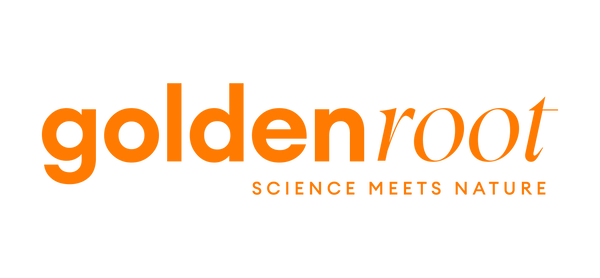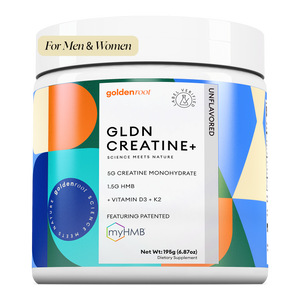GLP-1 receptor agonists have quickly reshaped how we approach weight loss and metabolic health. But along with their benefits, one challenge stands out: muscle loss during rapid weight reduction!
Protecting your muscle mass isn't a nice-to-have if you’re using a GLP-1 medication like semaglutide or tirzepatide. It’s essential for long-term metabolic health and quality of life.
That’s where creatine and HMB (β-Hydroxy β-Methylbutyrate) come into play. Both supplements are heavily studied, but when combined, they form a powerful duo that can help safeguard muscle while enhancing overall body composition.
Related products:
- natural supplements for anxiety and sleep
- creatine and HMB for aging muscle
- berberine for weight loss and metabolism
Why Muscle Preservation Matters on GLP-1 Therapies?
GLP-1 medications work by slowing gastric emptying, curbing appetite, and improving blood sugar control. These effects often lead to substantial weight loss, but roughly 25-40% of that weight loss can come from lean muscle tissue, especially without resistance training or nutritional support.
Muscles play a critical role in metabolism, mobility, insulin sensitivity, and even longevity. Maintaining it during weight loss improves how you feel and can make your fat loss more sustainable.
Read more: Vitamin D3 and K2 for Bone Health: Protecting Your Skeleton on GLP-1 Medications
How Creatine Supports GLP-1 Users?
Creatine monohydrate is one of the most researched supplements in sports nutrition.
It helps muscles regenerate ATP {the energy currency of your cells} during high-intensity activity.
For GLP-1 users, this means better gym performance, improved recovery, and direct muscle support.
Key Benefits of Creatine:
- Supports lean muscle mass during caloric deficits.
- Enhances strength and power during workouts.
- May reduce mental fatigue and support cognitive health (especially helpful with GLP-1 fatigue).
Why HMB Complements Creatine?
HMB has been studied for its unique ability to slow muscle protein breakdown.
It stabilizes muscle cell membranes and activates pathways linked to muscle retention, making it especially useful during times of stress, injury, or calorie restriction.
Read more: A Beginner’s Guide to Supplementing While Taking GLP-1 Drugs
Key Benefits of HMB:
- Reduces muscle protein breakdown.
- Supports recovery and preserves lean tissue.
- May improve mobility and muscle function as you age.
When taken together, creatine and HMB work on complementary pathways.
Creatine boosts energy production and performance, while HMB helps lock in muscle tissue by minimizing breakdown.
Why GLDN Creatine + HMB Stands Out?
Not all supplements combine these two ingredients effectively.
GLDN Creatine + HMB brings together 5g of creatine monohydrate with 1.5g of clinically validated myHMB®, plus added Vitamin D3 and K2 to support bone health and joint function, {both important during weight loss and aging}.
-
myHMB® has been shown in clinical studies to reduce muscle loss and improve strength.
-
Vitamin D3 + K2 help direct calcium to the bones and support mobility.
-
Gluten-free, dairy-free, dye-free, and paleo-friendly.
Read more: how much water to drink with creatine
What’s the Ideal Creatine Dosage for Muscle Growth?
Daily intake recommendations are explained below:
For GLP-1 users or anyone aiming to preserve muscle during weight loss:
-
5g creatine monohydrate daily (standard dose)
-
Optional loading phase: 20g/day for 5-7 days (split into 4 doses)
For HMB:
-
1.5-3g myHMB® per day (clinical range)
Consistency matters more than timing; pairing it with resistance training amplifies benefits.
Read more: Who Should Think Twice Before Taking GLP-1 Drugs for Weight Loss?
Can Creatine Help With Fat Loss?
While creatine doesn’t directly burn fat, it can indirectly help:
- Preserves lean mass, keeping your metabolism higher.
-
Enhances workout quality, leading to more calories burned.
-
May improve insulin sensitivity; an added bonus for GLP-1 users managing blood sugar.
Creatine Monohydrate vs. HCL: Which Is Better?
For most users, creatine monohydrate remains the gold standard.
It’s effective, affordable, and well-studied. Creatine HCL has better solubility, but clinical benefits over monohydrate aren’t significantly superior.
Creatine for Beginners: What You Need to Know
As one of the most researched supplements in sports nutrition, creatine monohydrate is safe and easy to use, even if you’re brand new to supplements.
Read more: What Effect Do GLP-1 Drugs Have on Bone Health and Muscle?
First-Time Use, Loading Phase { Creatine }
If you’re new to creatine:
-
Start with 5g/day & no need to overcomplicate it.
-
Stay hydrated, as creatine pulls water into muscles.
- Expect mild weight gain (~1-2 lbs) from increased water retention (this is intracellular and healthy, not fat gain).
Read more: Creatine: Not Just for Muscles, A Boost for Your Brain Too
Should You Take Creatine After a Workout?
While you can take creatine at any time of the day, research suggests that post-workout supplementation may be slightly more effective.
Best Timing Strategies for Creatine
You can take creatine anytime, but research leans slightly in favor of post-workout intake for muscle retention and growth. If you're pairing it with HMB, take both together daily for convenience.
The Bottom Line
For GLP-1 users, combining creatine and HMB is a smart, research-backed strategy for defending muscle mass and supporting strength and recovery.
If you’re ready to support your muscles and metabolism while navigating your weight loss journey, GLDN Creatine + HMB delivers a clean formula that checks all the boxes for you!
Read more: is creatine safe while breastfeeding



